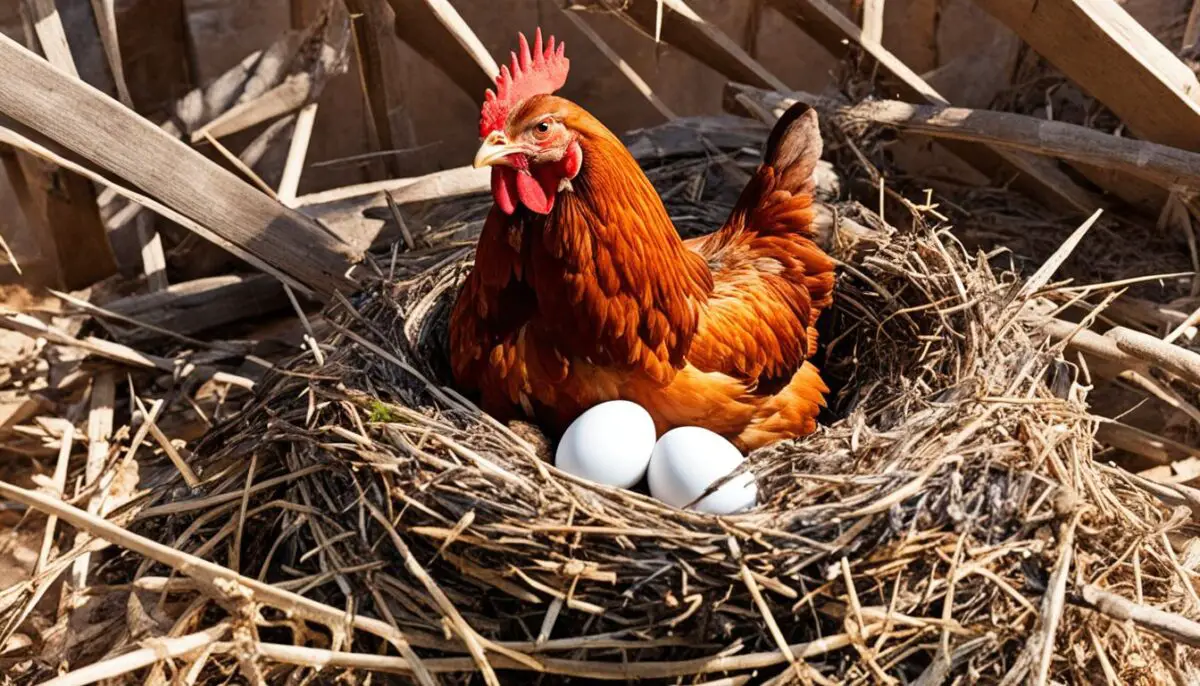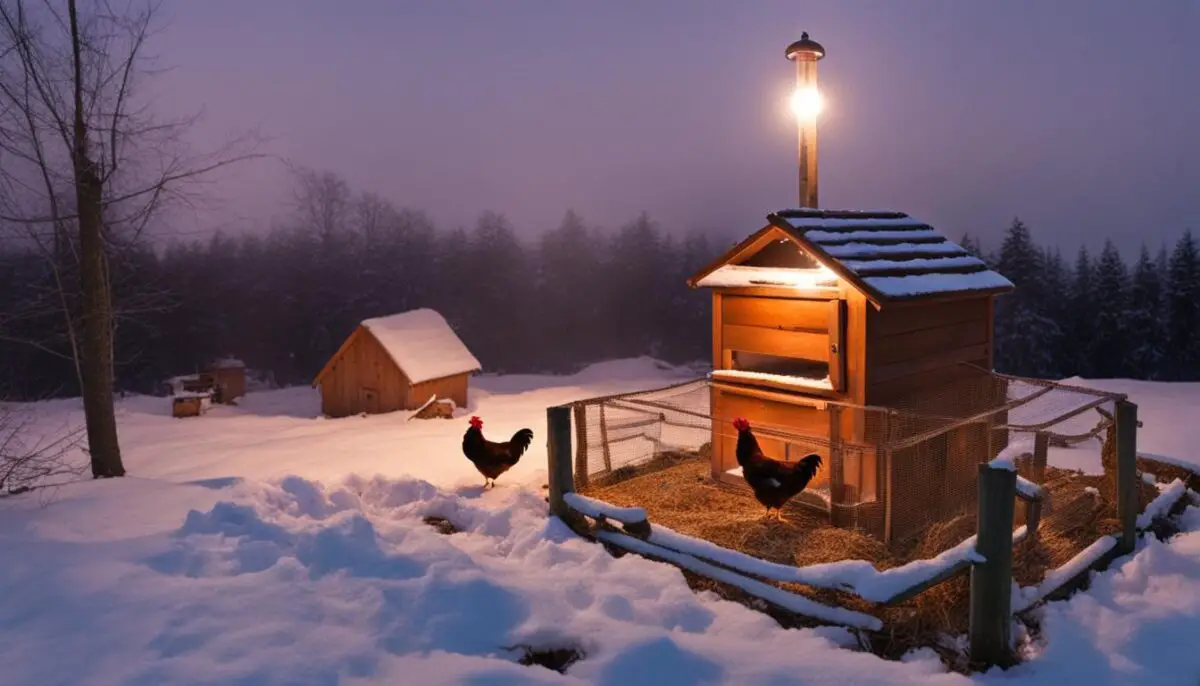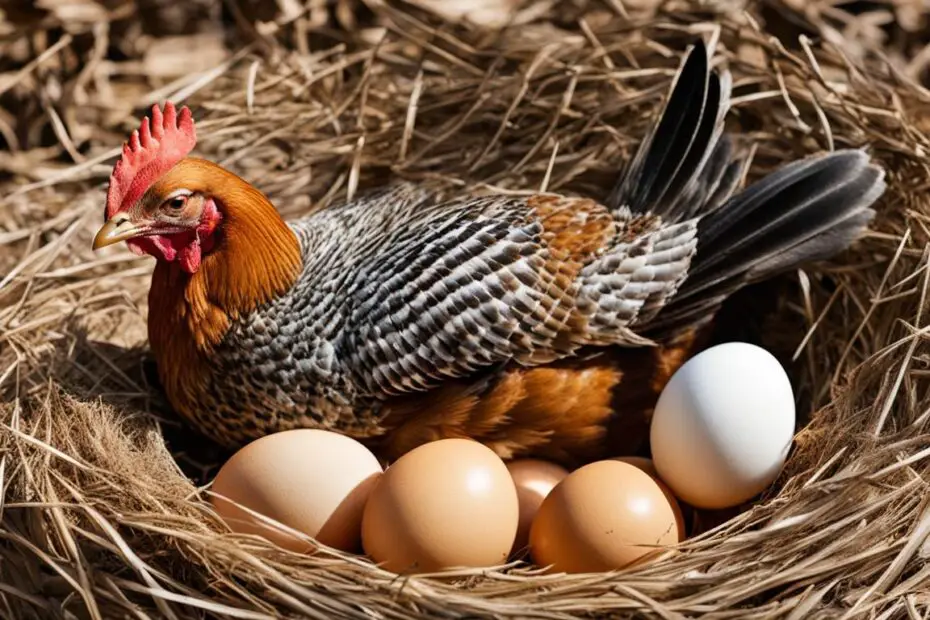Welcome to our article on the egg-laying span of chickens! If you’ve ever wondered how long chickens can lay eggs or how the chicken reproductive cycle works, you’re in the right place. Understanding the duration and factors that influence egg production in chickens is valuable information for both hobbyists and commercial poultry farmers.
Chickens have an average lifespan of 6-8 years, but their egg-laying capacity typically lasts for 3-4 years. Commercial layers, specifically bred for egg production, are usually kept for 2-3 years as their egg production declines after this time. To ensure a consistent egg supply, it’s essential to retire old hens and introduce young hens every 2-3 years.
Key Takeaways:
- Chickens can lay eggs for an average duration of 3-4 years.
- Commercial layers are typically kept for 2-3 years.
- Old hens should be retired and young hens introduced every 2-3 years for a consistent egg supply.
- Egg production starts at around 18-22 weeks of age for chickens, given ideal conditions.
- Proper day length, nutrition, and management are crucial for optimal egg production in chickens.
Factors Affecting Egg Laying in Chickens
The level of egg production, egg size, and shell quality decrease each year in chickens. This decline is influenced by various factors that impact the overall health and productivity of the birds.
Breed
Different chicken breeds have varying genetic potential for egg production. Some breeds are specifically bred for high egg production, while others prioritize meat production. It’s important to choose a breed that is known for its egg-laying capabilities if maximum egg production is desired.
Housing and Environment
The housing and environment in which chickens are kept can significantly affect their egg-laying ability. Chickens require a comfortable and stress-free environment to lay eggs consistently. Factors such as temperature, ventilation, lighting, and nest box availability should be carefully managed to encourage optimal egg production.
Weather
Extreme weather conditions can impact egg production in laying hens. High temperatures during the summer months can cause stress and decrease egg production. Similarly, extremely cold temperatures can also reduce egg production during the winter. Providing proper shelter and ventilation can help mitigate the effects of weather on egg-laying performance.
Management
Effective management practices play a crucial role in maximizing egg production in laying hens. This includes proper flock health management, regular vaccinations, effective parasite control, and optimal nutrition. Monitoring the overall health of the flock and addressing any issues promptly can help maintain consistent egg production.
Nutrition
Proper nutrition is essential for ensuring optimal egg production in chickens. A balanced diet that provides all the necessary nutrients, including proteins, vitamins, and minerals, is crucial. Feed composition should be adjusted based on the specific requirements of the laying hens at different stages of their production cycle.
Supplemental Lighting
The duration of daylight has a significant impact on egg-laying in chickens. The natural decrease in daylight hours during fall and winter can cause a decline in egg production. However, providing supplemental lighting for a consistent 16 hours of light per day can help stimulate egg-laying and maintain consistent production throughout the year.
Parasite Load
Heavy parasite infestations can cause stress, discomfort, and decreased egg production in chickens. Regular deworming and proper parasite control measures should be practiced to minimize the negative impact of parasites on egg-laying performance.
Factors Affecting Egg-Laying in Chickens
| Factors | Impact |
|---|---|
| Breed | Influences genetic potential for egg production |
| Housing and Environment | Affects the comfort and stress levels of the birds |
| Weather | Extreme temperatures can impact egg-laying |
| Management | Proper flock health management is essential |
| Nutrition | A balanced diet is crucial for optimal egg production |
| Supplemental Lighting | Ensures consistent daylight hours for stimulation |
| Parasite Load | Heavy infestations can decrease egg production |
Understanding and effectively managing these factors can help poultry farmers optimize egg-laying performance in their flocks.
By providing the right conditions, nutrition, and management practices, farmers can support their chickens’ natural ability to lay eggs consistently.

Egg Production and Longevity
When it comes to the lifespan of egg production in chickens, it’s important to understand that their egg-laying capacity can vary over time. While hens can live for an average of 8-10 years, their peak egg production typically occurs in the first year of laying.
During their first year, hens reach their highest level of egg production at around 30 weeks of age. As they continue to mature, the number of eggs laid increases, while the size of the eggs tends to even out.
By the second year, hens will lay around 80% of their first-year egg production. In the third year, egg production is estimated to be just under 70% of the first year, and by the fourth year, it drops to about 60%.
Although egg production declines as hens age, it’s important to note that chickens can live several years after they stop laying eggs. This extended lifespan provides opportunities for their owners to continue benefiting from their companionship and valuable contributions to the flock.
In fact, hens can still serve various purposes even after their egg-laying days are over. For example, they can continue to help control bugs, weeds, and pests in the surrounding area. Additionally, some owners choose to harvest them for meat, although it’s worth noting that the meat of laying hens might not be as abundant or tender as that of meat-type chickens.
| Year of Egg Production | Percentage of First-Year Egg Production |
|---|---|
| First year | 100% |
| Second year | 80% |
| Third year | ~70% |
| Fourth year | ~60% |
While each hen’s egg-laying span may vary slightly, understanding the progression of egg production over time can help chicken owners effectively manage their flock and make informed decisions about retiring older hens or integrating new ones.

Supplemental Lighting and Winter Egg Production
During the winter months, many chicken owners wonder if hens continue to lay eggs. The answer is yes! While the natural decrease in daylight hours during winter can impact egg production, it is possible to maintain a steady supply of eggs by providing supplemental lighting.
Do hens lay eggs in the winter?
The ovulation cycle of hens is influenced by the length of the day. Generally, hens require about 16 hours of daylight to achieve maximum egg production. However, with the use of artificial lights, egg production can be sustained throughout the year.
Chicken egg laying period in winter
By supplementing artificial light, hens can continue laying eggs during the darker months. Providing 14-16 hours of light each day is recommended to mimic the longer daylight hours of summer. This extended period of light helps to stimulate egg production and maintain consistent laying throughout the year.
To implement supplemental lighting, a timer-controlled 60-watt incandescent bulb can be used. It is essential to place the light in a position where it reaches the chickens evenly and covers their entire living space. Timers can be set to simulate the natural sunrise and sunset, allowing hens to naturally roost during the evenings.
Benefits of Supplemental Lighting:
“By providing supplemental lighting, chicken owners can enjoy a steady supply of fresh eggs year-round. This is especially beneficial for those who rely on their hens for eggs or have a business that depends on consistent egg production.”
However, it is important to note that while supplemental lighting can encourage hens to lay eggs in the winter, it is still advisable to allow them a natural resting period. Allowing hens to take a break from laying eggs for a few weeks during the coldest months can provide physiological benefits and improve their overall health and well-being.
To summarize, while hens naturally have a decrease in egg production during the winter months, providing supplemental lighting can ensure a consistent egg supply. By mimicking longer daylight hours, hens can continue to lay eggs even in darker seasons. As responsible chicken caretakers, it’s crucial to balance their natural rest periods with the desire for year-round egg production.

End of Egg-Laying and Alternatives
While the primary purpose of laying hens is to provide a steady supply of eggs, some people may wonder if these hens can also be harvested for meat. The answer is yes, laying hens can be consumed for meat. However, there are a few factors to consider.
Unlike meat-type chickens specifically bred for their tender and abundant meat, the genetics of laying hens prioritize egg production. As a result, their meat tends to be tougher and less plentiful. That being said, there are methods to make laying hen meat more edible.
One option is to stew laying hen meat, which involves slow cooking the meat in a flavorful broth to soften it. Another popular alternative is to use laying hen meat in soups, where the broth and other ingredients can add moisture and enhance the overall taste.
It’s important to note that while laying hens can be harvested for meat, many small flock owners choose not to do so. This is because even after their egg-laying period ends, hens can live for several more years in retirement. Instead, they are often kept for other purposes such as bug catchers, weed controllers, or as broodies for hatching eggs.
Overall, while laying hens can be utilized for meat, it’s essential to consider their genetics for egg production and the potential challenges in achieving tender and abundant meat. Retiring laying hens to fulfill other roles can be a rewarding alternative for many small flock owners.
Conclusion
Throughout their lifespan, chickens have a natural egg-laying period that typically lasts for about 3-4 years. This phase begins when the hens reach 18-22 weeks of age, provided they have the right conditions such as appropriate day length, proper nutrition, and effective management strategies. During this productive period, factors like breed, nutrition, management, and day length can influence the overall egg production of chickens.
While the egg-laying capacity gradually decreases over time, it’s important to note that hens can live for several years after they cease laying eggs. On average, chickens have a lifespan of 8-10 years, which means they can contribute to the flock even beyond their productive years. Owners have the option to retire old hens and find alternative uses for them, such as bug control or preparing flavorful stewing meat.
Proper care and management play key roles in maximizing the egg-laying period and ensuring the overall well-being of chickens. This includes providing a suitable environment, balanced nutrition, and adequate lighting conditions. By implementing these practices, chicken owners can effectively manage and maintain a steady supply of fresh eggs while nurturing the health and longevity of their flock.
FAQ
How long can chickens lay eggs?
Chickens can lay eggs for about 3-4 years.
What factors affect egg laying in chickens?
Factors such as breed, management, nutrition, and day length can impact egg production in chickens.
How many years can chickens lay eggs?
Chickens can typically lay eggs for 3-4 years, with commercial layers usually kept for 2-3 years.
Do hens lay eggs in the winter?
Hens lay fewer eggs in the fall and winter, but supplemental light can extend their egg production into these seasons.
Can laying hens be harvested for meat?
Yes, laying hens can be consumed for meat, although their meat may be tougher and less abundant compared to meat-type chickens.
How long do chickens live?
Chickens have a lifespan of 6-8 years on average, with hens typically living 8-10 years even after they stop laying eggs.

